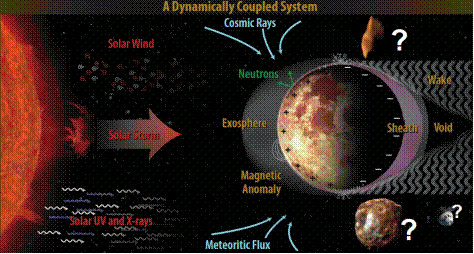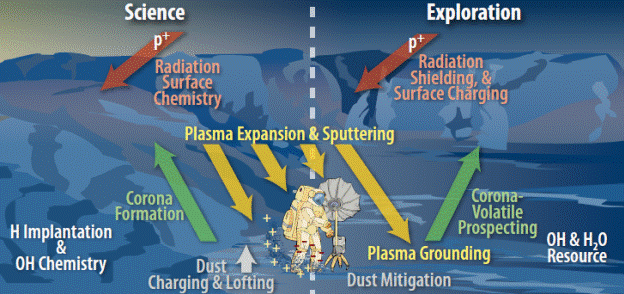DREAM2 Science
As astronauts approach a Near Earth Asteroid (NEA), they will need to be aware of many environmental challenges, including hazardous secondary neutrons, their own contamination of the fragile object, and the optimal 'first contact' location to reduce electrostatic discharge and dust cohesion effects. As part of SSERVI, the Dynamic Response of the Environments at Asteroids, the Moon, and moons of Mars (DREAM2) team investigates and evaluates the harsh surroundings at these targeted airless bodies, seemlessly incorporating human systems as an integrated component of the environment. In essence, human systems are treated as small bodies electrically, physically, and chemically interacting with the larger target airless bodies. DREAM2 is a necessary modeling, laboratory, and data validation center that reveals and assesses the environment-surface-object interaction at the targeted airless bodies.
Without dense atmospheres and large magnetic fields, airless bodies and human systems are exposed directly to the harsh space environment, including space plasmas, UV- and x-rays, micro-meteoroid impacts, and high energy charged particle radiation. In direct response to this energy, bodies react by emitting neutral and ion vapors, by altering the flow of the surrounding space plasma, and by creating high energy secondary radiation. Some of this space environmental energy is also absorbed by the surface to permanently modify its solid state nature. To understand the connection between the space environment's coupled and dynamic interactions with exposed rocky bodies and human systems, the DREAM2 space environment center will advance key science themes that seamlessly intertwine into exploration applications.
Like its predecessor, DREAM, this new center is led by Goddard Space Flight Center (GSFC) and includes twelve expert institutional partners that specialize in the space environment/surface interactions. This integrated expertise forms a mosaic that creates a more complete picture of the space environment at an exposed surface. DREAM2 addresses this fundamental question:
"How do the highly-variable energy and matter in the space environment affect volatile stability, exosphere formation, plasma interactions, surface micro-structure, and visiting human systems at any exposed rocky body?"

Figure 1: DREAM2 extends our understanding of the dynamic space environment at the Moon, at small bodies, and at human systems
Figure 1 illustrates the dynamic space environment at exposed bodies. Each body is rich in emission and ejecta stimulated by environmental energy, but the details of the processes that create this animated system are not well understood. It also remains unclear if this coupled environmental system operates in the same way at each body. Processes understood at one body have not been studied or modeled in context at the other bodies. DREAM2 thus specifically compares and contrasts the plasma interaction regions, exospheres, radiation, and associated surface modification as a function of body mass and body-sun distance.
DREAM2 brings together a set of modelers and data analysts that provide the new insights into space environments at these exposed rocky bodies. The team will also run their models as a linked set during our DREAM2 Extreme Environment Program (DEEP). During DEEP, inputs and outputs from a set of models will be linked together to provide a meso-scale modeling effort of extreme environmental affects at asteroids, Phobos and the Moon. We will answer questions like: What happens when a solar storms is incident at a near-Earth Asteroid? What are the volatile and plasma interactions when a human spacecraft comes close to an asteroid?
We find that each aspect of the space environment studied by DREAM2 has both science and exploration manifestations. Figure 2 shows the complementary views of the space environment from a science perspective (left) and exploration perspective (right). The same region, the same human system, and same influences are present in both perspectives - with DREAM2's science perspective filling key knowledge gaps on the environmental challenges that are encountered by exploration of the Moon, NEAs, and the moons of Mars. High energy charge particle radiation can create new chemistry in regolith and ices, but this aspect of the environment makes it a human health hazard. Exposed bodies are immersed in plasma that makes the medium naturally conducting, and all systems are grounded to the plasma. DREAM2 will consider what happens in shadowed regions where the plasma has difficulty entering, effectively changing the very nature of the electrical ground. At the surface, volatiles can be released which form an exosphere or corona, but can also be used for prospecting. While the interaction of solar wind protons in the oxide-rich regolith may create OH, this interesting basic science pursuit connects directly to exploration's search for usable resources.

Figure 2: DREAM2 explores the interconnected science and exploration aspects of the space environment at a Target Body. The various environmental influences are viewed from their science perspective on the left and complementary exploration perspective on the right.

